Homemade Cream Cheese 2 Ways
Of all the delicious indulgences, cream cheese is one of my favorites! And it’s surprisingly simple to make yourself. There are two methods for making homemade cream cheese—both requiring only a couple of easy steps and minimal ingredients. Let’s dive in!
Home Dairy
One of my favorite things about this homesteading life is that we now regularly make things from scratch that previously I had only ever experienced from a package!
When we got our family milk cow, Thimble, all of the sudden a whole new world of homemade dairy-based recipes became everyday staples. From hard and soft cheeses to butter, yogurt, sour cream, and now cream cheese. But, don’t worry, family milk cow or not, homemade cream cheese is very doable for anyone!

The History of Cream Cheese
Cream cheese has its roots in Normandy, France where it was recorded as far back as 1583 but may go back significantly earlier than that. It was called Neufchatel Cheese. This cheese was aged making it different than the standard American counterpart. It had a semi-soft and crumblier texture.
Cream cheese first came on the scene in American in the 1870’s. A New York farmer named William Lawrence was making traditional Neufchatel to sell to an upscale New York store when they requested an even richer cheese.

Lawrence began adding cream to his Neufchatel and started calling it Neufchatel & cream. At the time, this first version of American cream cheese was very expensive and could only be found in high end restaurants. But after other farmers learned the recipe, it became more commonplace.
After some time, cheese broker Alvah Reynolds suggested that Lawrence rebrand his cream cheese under the name Philadelphia Cream Cheese since Philadelphia was known for making high quality cheeses. Demand rose, so Lawrence began selling cream cheese from other farmers. In 1928, his company (The Phenix Company) merged with Kraft and the rest is history.
2 Methods for Homemade Cream Cheese
When it comes to making cream cheese, you are likely to come across two ways to do so.
The first is a cultured cream cheese method. It is made by culturing cream and milk together for 12-14 hours with a culturing agent (we’ll go more into that below) and rennet. This method is our personal favorite.
Raw milk is not a necessity in this recipe. But we do appreciate that if you are using raw milk, you do not need to heat the milk above 100°F keeping all the beneficial bacteria and organisms intact.
Also, the act of culturing with the addition of rennet not only provides increased nutritional and health benefits but it also yields more cream cheese and provides that distinct, rich cream cheese flavor.
The second is a quick cream cheese that can be made in just a few minutes and only requires milk, an acid, and heat to come together.

This quick recipe is great if you need cream cheese fast! Instead of culturing for several hours, this recipe can be made in about 15 minutes.
Another advantage to this method is that only 2 ingredients are necessary (milk and an acid). And because this cream cheese recipe will be heated to boiling, any kind of milk is fine to use (other than UHT – ultra high temperature milk).
Homemade Cultured Cream Cheese Recipe
Yield: Roughly 2 cups cream cheese
While the idea of culturing something or adding rennet may sound intimidating, I promise this recipe is not! All that is needed to make cultured cream cheese is:
Ingredients:
2 cups Whole milk
2 cups Cream
2 Tbsp buttermilk or yogurt (only if you are using raw milk/cream) OR mesophilic starter culture
3 drops liquid Rennet or enough tablet rennet to coagulate one quart of milk (this was ¼ tablet in our case)
2-3 tbsp water
½ tsp salt
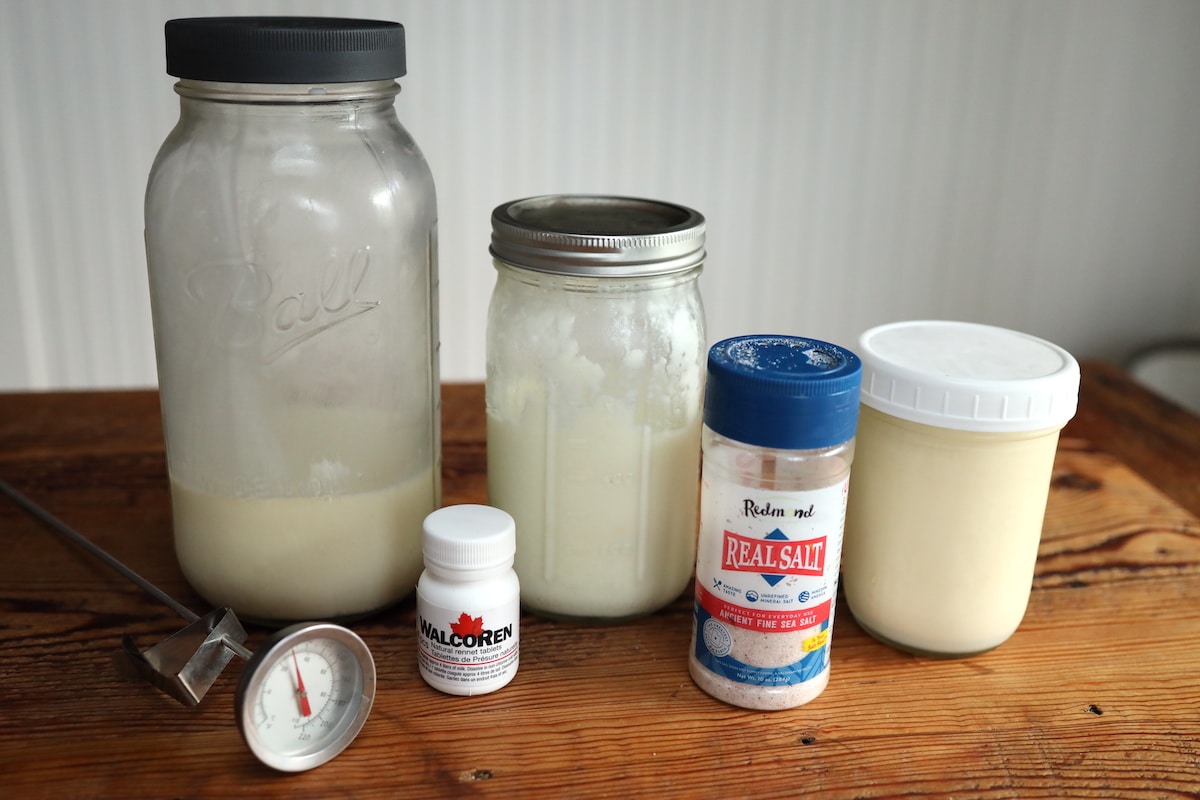
Directions:
1. In a sauce pan, mix whole milk, cream, whatever you are using for your culture, and salt together.
2. Set aside and prepare your rennet by dissolving either 3 drops of liquid rennet into 2-3 tbsp of water or enough tablet rennet to coagulate a quart of milk. The liquid rennet is easier for this recipe. But a tablet will work—just make sure it is completely dissolved in the water.
3. Heat sauce pan over low heat until it reaches roughly 85°F (30°C). Stir continuously—it will heat quickly.
4. Once your milk mixture has reached temperature, remove from heat and quickly and thoroughly stir in the dissolved rennet in water.
5. Place lid on pot and cover with towels for insulation. Let set for 12-14 hours. It will work best if you can keep your cream cheese at a warm temp around 75-80°F to culture.
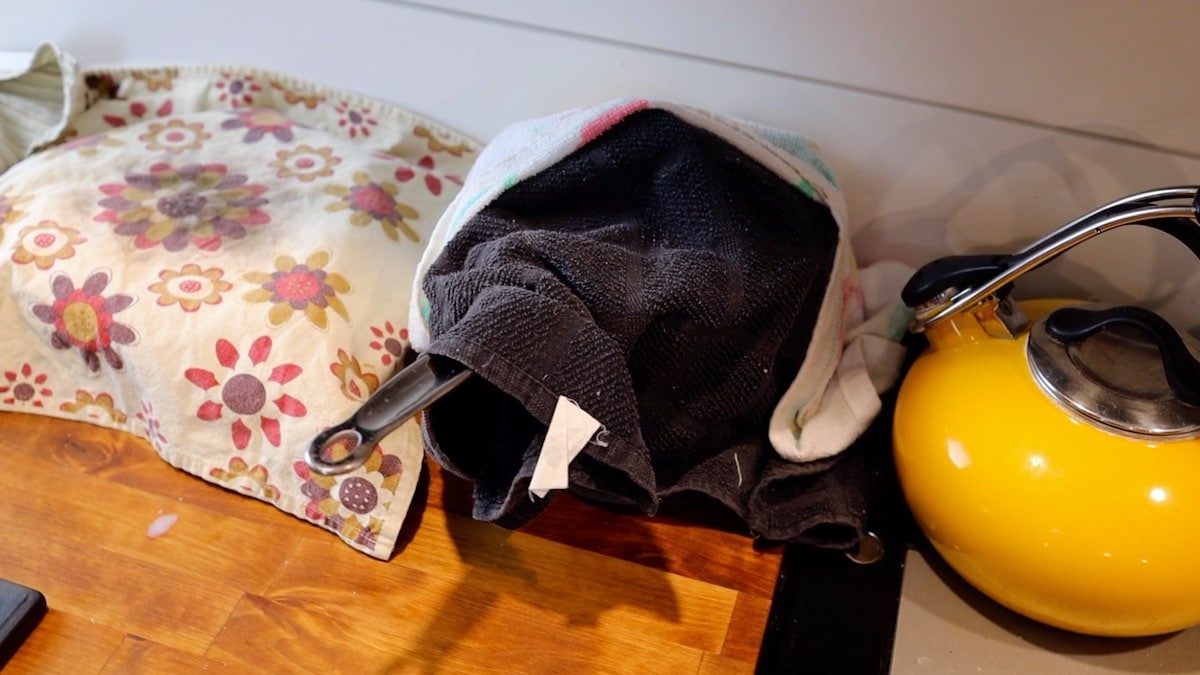
6. After 12-14 hours, strain the curd from the whey. I do this by lining a mesh strainer with a cheese cloth and letting it strain for an hour or two. To fully get the whey out you may need to gather the sides of the cheesecloth to hang or squeeze any liquid from the curd.

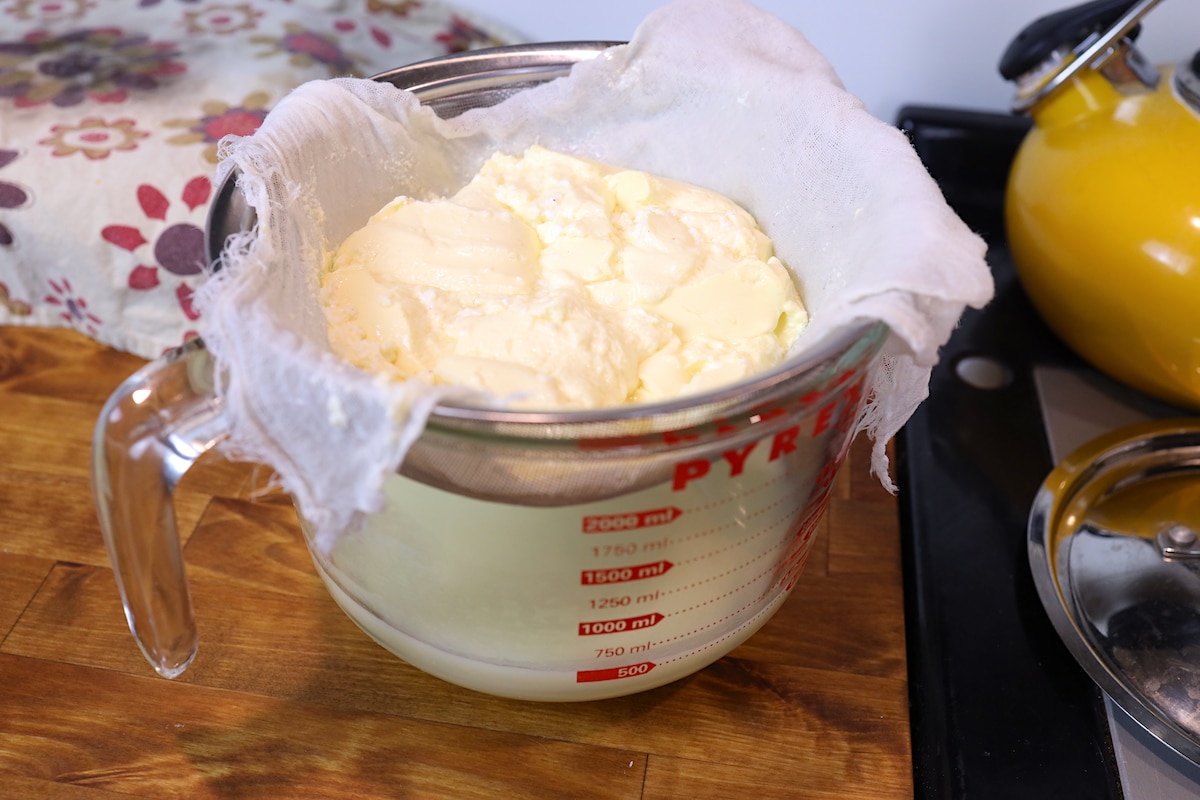
The resulting product in a smooth, creamy and delicious cultured cream cheese.
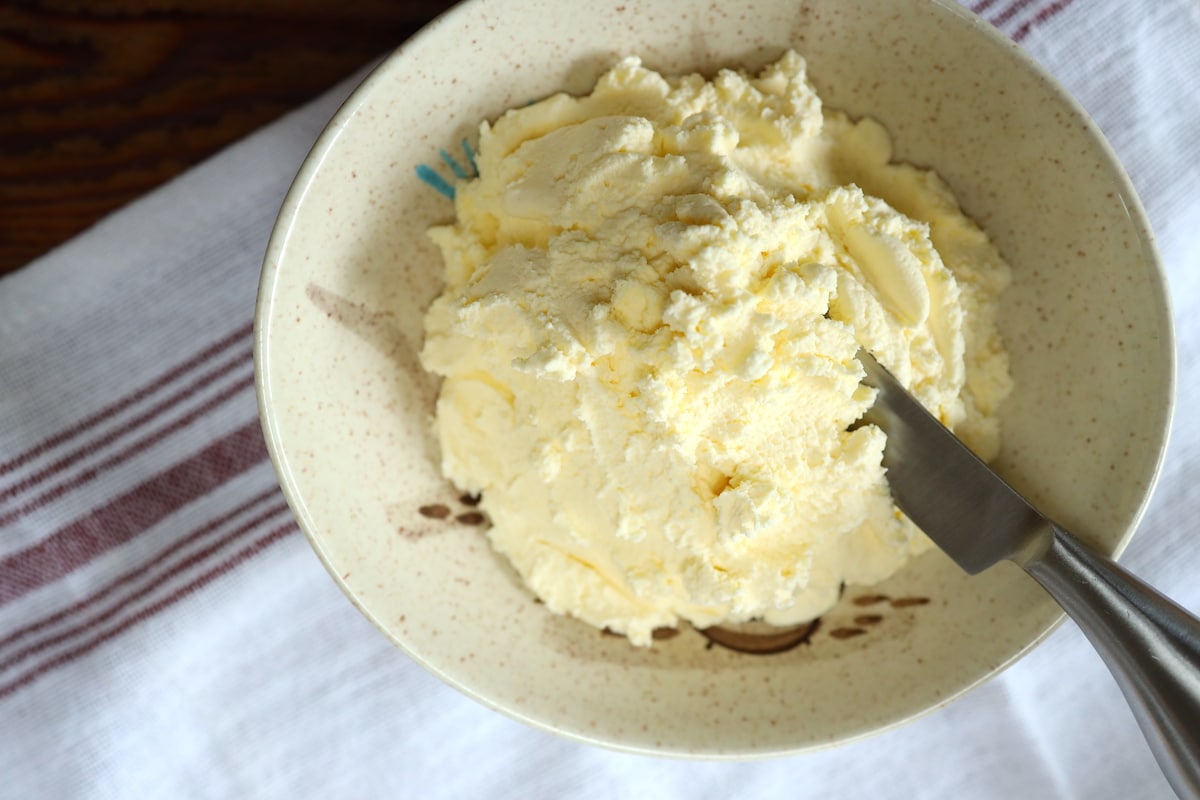
Homemade Cultured Cream Cheese Frequently Asked Questions:
How long will homemade cultured cream cheese last?
This cultured cream cheese will last up to 2 weeks in the fridge.
What kind of milk/cream can I use?
You can use either raw or store-bought whole milk and cream. The main difference is that if you use a pasteurized milk, you must use a mesophilic starter culture or cultured buttermilk as a starter. If you are using raw milk, you can use yogurt. Although, technically a starter culture isn’t even necessary because of the native bacteria and enzymes in raw milk that culture it naturally.
Can I flavor homemade cultured cream cheese?
Yes! There is salt added to the recipe but feel free to add savory or sweet herbs and spices to your cream cheese depending on how you plan to use it!
Best uses for homemade cream cheese?
We’ve had success using this recipe for any of the same applications you would use store bought cream cheese. From cheesecake to topping smoked salmon to spreading on a bagel—this cream cheese is great!

Homemade Quick Cream Cheese
The Science Behind How it’s Made
To make a quick version of homemade cream cheese, this is the perfect recipe! It requires only a couple of ingredients—milk and an acid.
In fact, this method of making cream cheese is identical to the process of making the cheese Paneer (minus the additional blending steps at the end). Paneer is a staple vegetarian food in India since it does not require rennet.
Quick cream cheese has unique biochemistry that distinguishes it form other cheeses. Most cheese melt when heated. Paneer, however, will never melt and always holds its form.
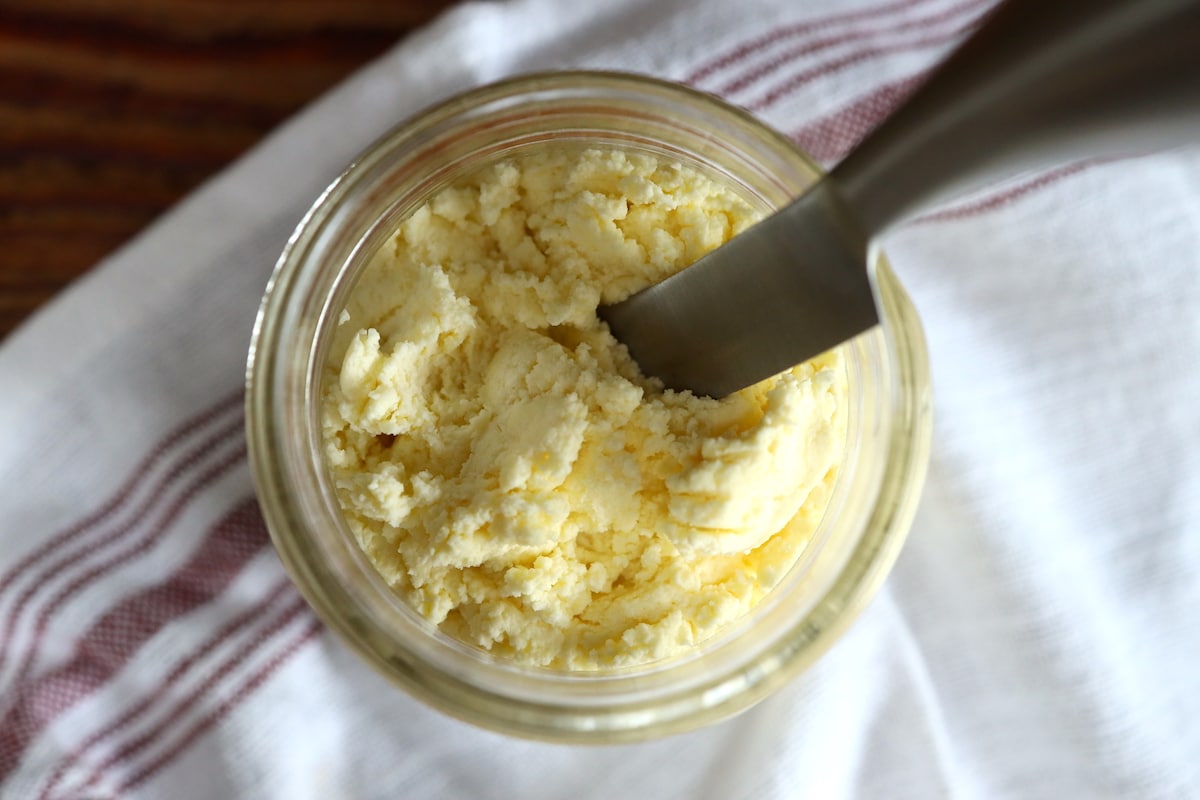
This is due to how it’s made. The most abundant protein in milk is casein. This is the protein that coagulates when rennet is used. But the second most abundant protein is albumin—the protein that makes up egg whites. Similarly to the way an egg white behaves when cooked, this cheese holds its form the same way.
To make this homemade cream cheese, you heat milk to boiling and then add an acid. When milk is heated to high temperatures, both proteins—casein and albumin—denature and become the curd that separates from the whey. Just as a cooked egg white cannot go back to liquid form, neither can this method of making cream cheese (or Paneer).
Quick Cream Cheese Recipe
Yield: Roughly 2 cups cream cheese
Ingredients:
1 Quart Milk
2 – 3 tbsp of acid (lemon juice, white vinegar, apple cider vinegar, etc.) or 2 cups of yogurt
Salt
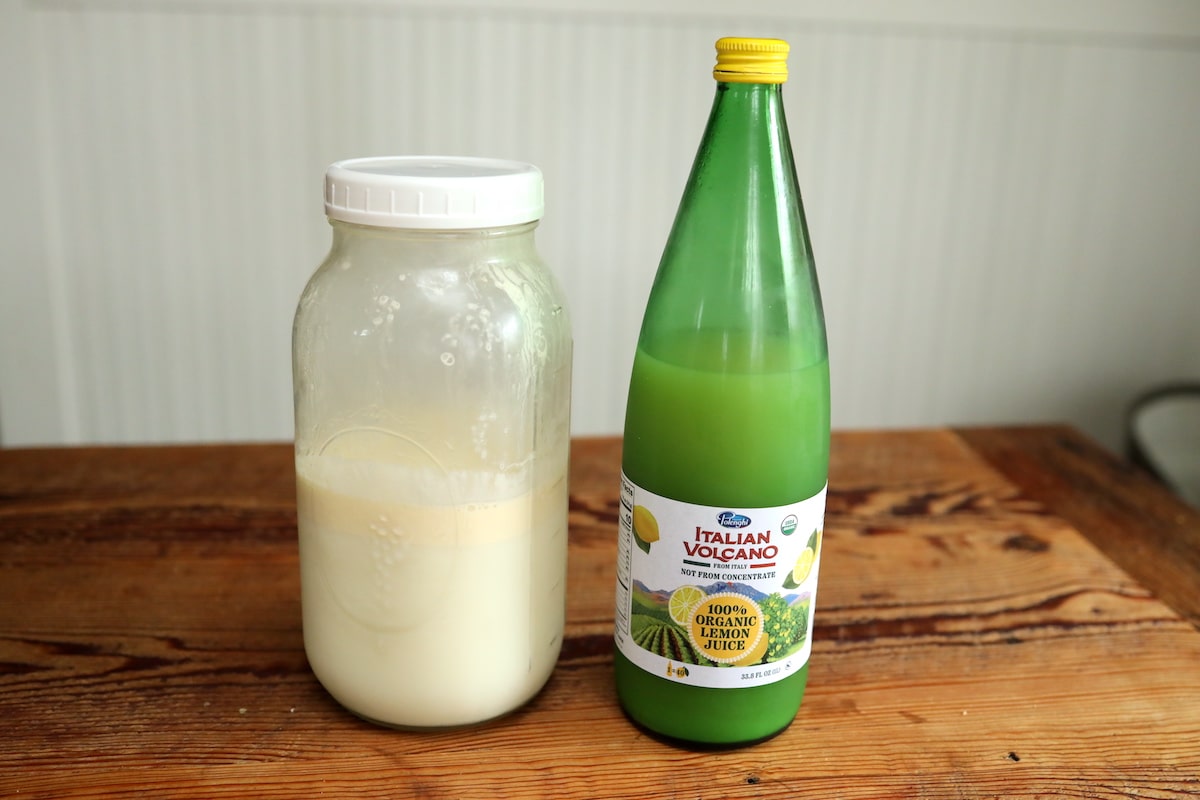
Directions:
1. Pour milk into a sauce pan.
2. Heat over med-high heat until it reaches a light boil. Stir continuously while heating to avoid the milk burning at the bottom of your pan.
3. Once a light boil is achieved, bring heat to low and quickly whisk in your acid.
4. Remove from heat and let the mixture sit for 10 minutes to let the curd separate from the whey.
5. After 10 minutes (likely this will happen sooner), you’ll see the curd floating on top, separated from the yellow/green whey.
6. Using a slotted spoon, scoop the curd into a mesh strainer lined with a cheese cloth.
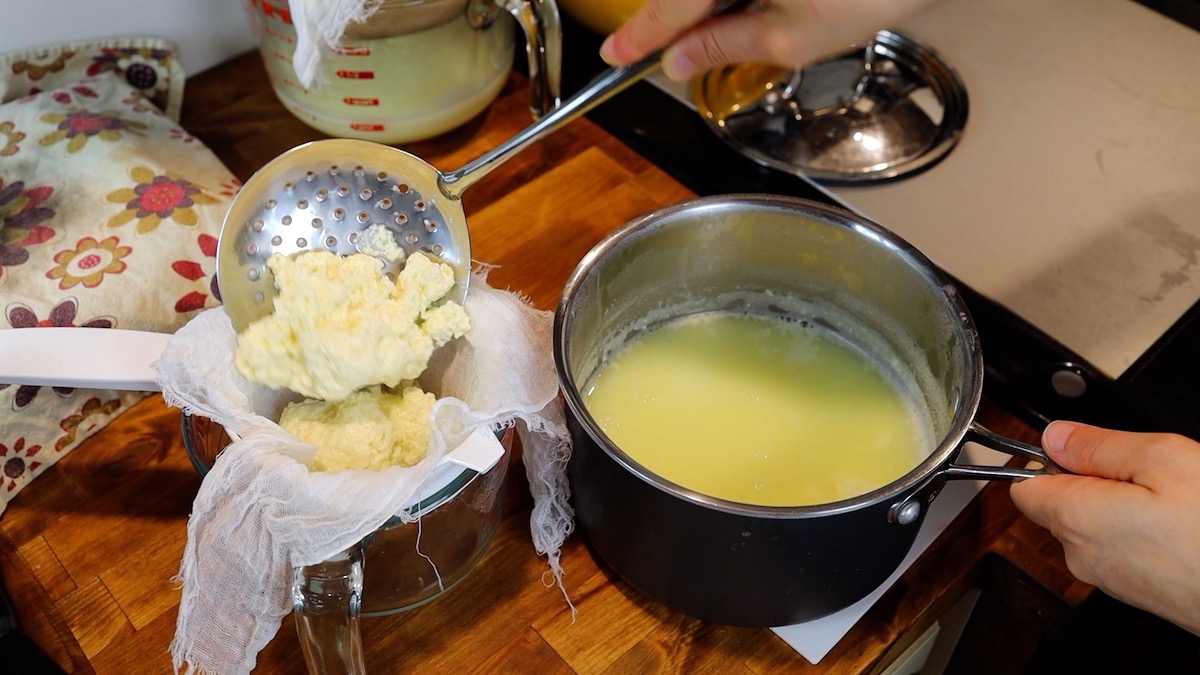
7. Strain the whey from the curd. You can squeeze out any excess whey with your cheesecloth but I don’t worry about getting all of the whey out because I think keeping some remaining whey helps the texture of the end result.
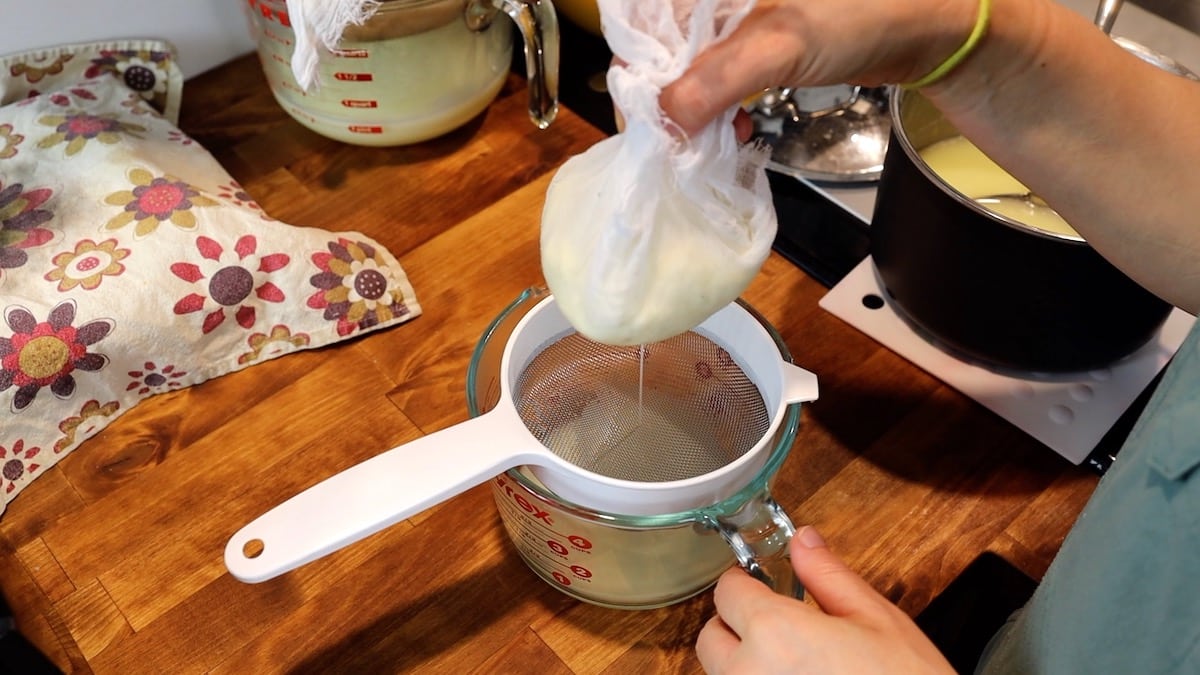
8. Place your curd into a high-powered blender or food processor and blend until desired texture is achieved. If the cream cheese still seems dry/gritty, add a bit of the reserved whey and mix again.
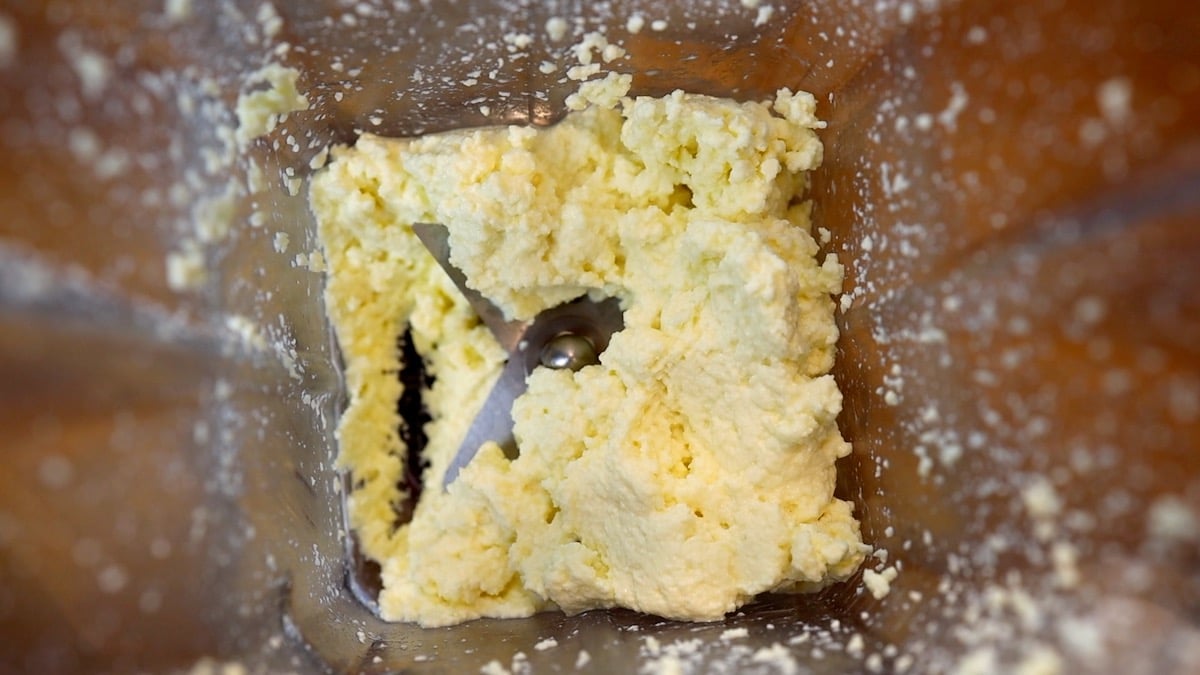
Once finished, store in the fridge for up to one week.
Homemade Quick Cream Cheese Frequently Asked Questions
What kind of milk should I use?
The beauty of this recipe is that any milk will work! While we definitely prefer a whole milk that is as minimally processed as possible, that’s not necessary for this recipe. This recipe can be made with milk that is raw, pasteurized, homogenized, and even skim. Just avoid UHT milk (ultra-high temperature).
Can I scale this recipe?
YES! This is a great way to use an abundance of milk you may have on hand that is beginning to get old and needs to be used up. Make a quart, a gallon, or even more of this cream cheese. Just make sure to scale the acid you add accordingly.
How does this recipe store?
Because this cream cheese is heated and not aged or cultured, it doesn’t have the bacteria and enzymes that help cheeses store well over time. It is best to store in the fridge and use within a week. This homemade cream cheese can also be frozen if needed.
What if my cream cheese turns out dry or grainy?
This is the biggest drawback to this recipe in my opinion. It can be tricky to nail the perfect creamy cream cheese texture. If your cream cheese turns out dry and grainy, the best thing to do is add a small amount of whey back into your cream cheese and re-blend or mix until a desired texture is achieved.
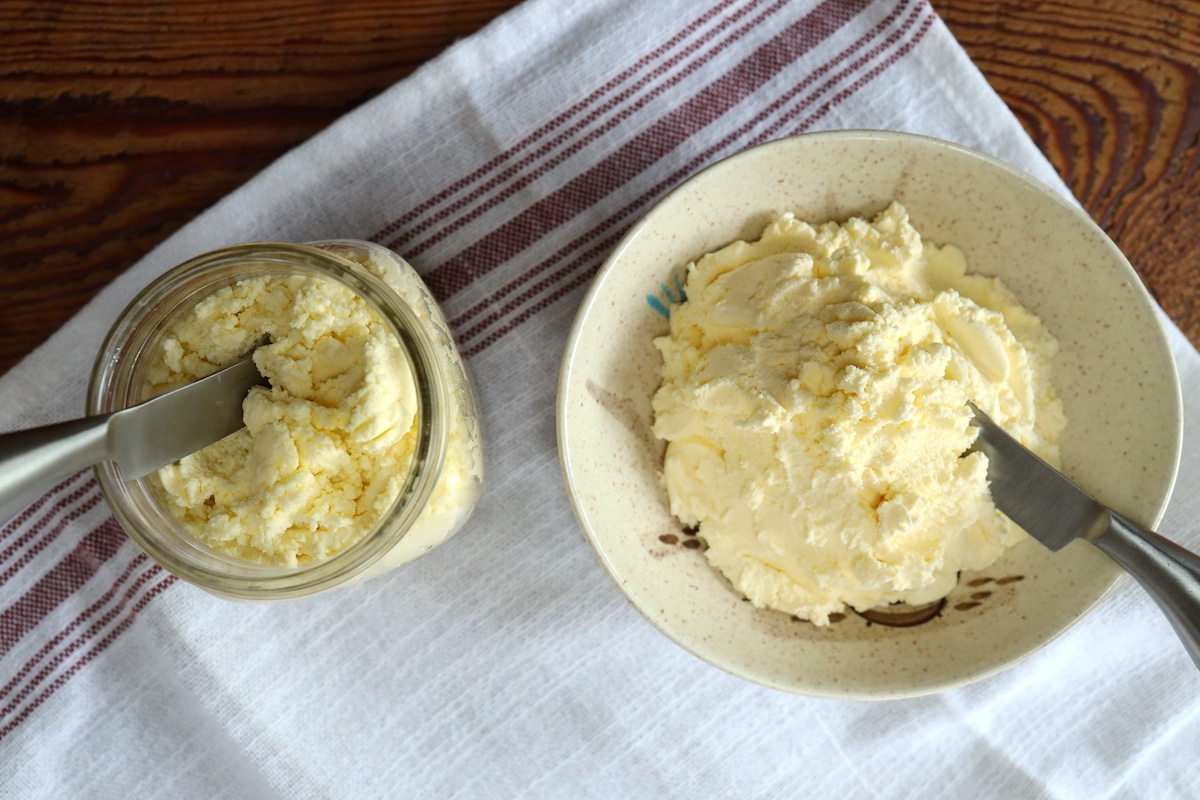
What do I do with this remaining whey?
The remaining whey can be used in place of broth or as a liquid in recipes in place of water. You can pour it over the garden or give it to animals. We always try to do something with our extra whey besides pouring it down the drain.
What kind of acid should I use?
The most common options are using some type of vinegar or lemon juice. Be aware that the cream cheese will take on the flavor of whatever you choose. If we are using the cream cheese for a dessert, I’ll often make it with lemon juice. Apple cider vinegar or balsamic vinegar will also give the cream cheese a unique flavor. Traditionally paneer was made by using yogurt or kefir as the acid. But you will need to add significantly more yogurt for acid than lemon juice or vinegar if you go that route.
Can I flavor homemade quick cream cheese?
Yes! The same as the other cream cheese recipe, feel free to add whatever herbs or spices you’d like.
Best uses for homemade cream cheese?
We’ve had success using this recipe for any of the same applications you would use store bought cream cheese.
For more easy recipes from our home dairy, check out:
How to Make Crock Pot Yogurt
The Best Vanilla Raw Milk Ice Cream
How to Make Butter from Raw Milk In a Blender
How To Make Quick and Natural Mozzarella Cheese with Vinegar
Easy Farmhouse Cheddar Hard Cheese Recipe
Some of the above links are affiliate links. This means we earn a small commission on qualifying purchases at no cost to you. We are so appreciative of your support!

Cultured Cream Cheese Recipe
This easy cream cheese recipe is for raw or pasteurized milk and cultures for 12-14 hours before it is strained and ready for use!
Ingredients
- 2 cups Whole milk
- 2 cups Cream
- 2 Tbsp buttermilk or yogurt (only if you are using raw milk/cream) OR mesophilic starter culture
- 3 drops liquid Rennet or enough tablet rennet to coagulate one quart of milk (this was ¼ tablet in our case)
- 2-3 tbsp water
- ½ tsp salt
Instructions
1. In a sauce pan, mix whole milk, cream, whatever you are using for your culture, and salt together.
2. Set aside and prepare your rennet by dissolving either 3 drops of liquid rennet into 2-3 tbsp of water or enough tablet rennet to coagulate a quart of milk. The liquid rennet is easier for this recipe. But a tablet will work—just make sure it is completely dissolved in the water.
3. Heat sauce pan over low heat until it reaches roughly 85°F (30°C). Stir continuously—it will heat quickly.
4. Once your milk mixture has reached temperature, remove from heat and quickly and thoroughly stir in the dissolved rennet in water.
5. Place lid on pot and cover with towels for insulation. Let set for 12-14 hours. It will work best if you can keep your cream cheese at a warm temp around 75-80°F to culture.
6. After 12-14 hours, strain the curd from the whey. I do this by lining a mesh strainer with a cheese cloth and letting it strain for an hour or two. To fully get the whey out you may need to gather the sides of the cheesecloth to hang or squeeze any liquid from the curd.
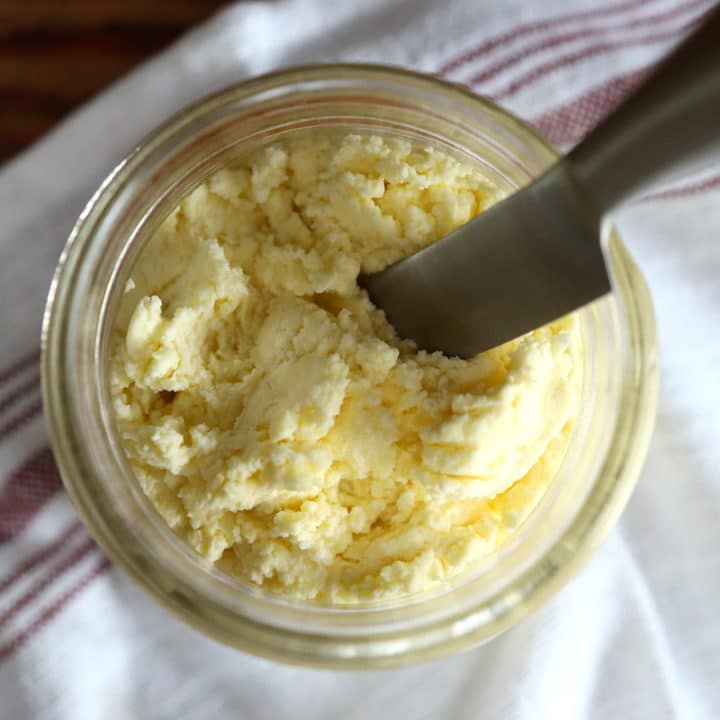
Quick Cream Cheese Recipe
This quick cream cheese recipe comes together in minutes, can be made with any type of milk, and only requires two ingredients.
Ingredients
- 1 Quart Milk
- 2 – 3 tbsp of acid (lemon juice, white vinegar, apple cider vinegar, etc.) or 2 cups of yogurt
- Salt
Instructions
1. Pour milk into a sauce pan.
2. Heat over med-high heat until it reaches a light boil. Stir continuously while heating to avoid the milk burning at the bottom of your pan.
3. Once a light boil is achieved, bring heat to low and quickly whisk in your acid.
4. Remove from heat and let the mixture sit for 10 minutes to let the curd separate from the whey.
5. After 10 minutes (likely this will happen sooner), you’ll see the curd floating on top, separated from the yellow/green whey.
6. Using a slotted spoon, scoop the curd into a mesh strainer lined with a cheese cloth.
7. Strain the whey from the curd. You can squeeze out any excess whey with your cheesecloth but I don’t worry about getting all of the whey out because I think keeping some remaining whey helps the texture of the end result.
8. Place your curd into a high-powered blender or food processor and blend until desired texture is achieved. If the cream cheese still seems dry/gritty, add a bit of the reserved whey and mix again.
Pin it for later!
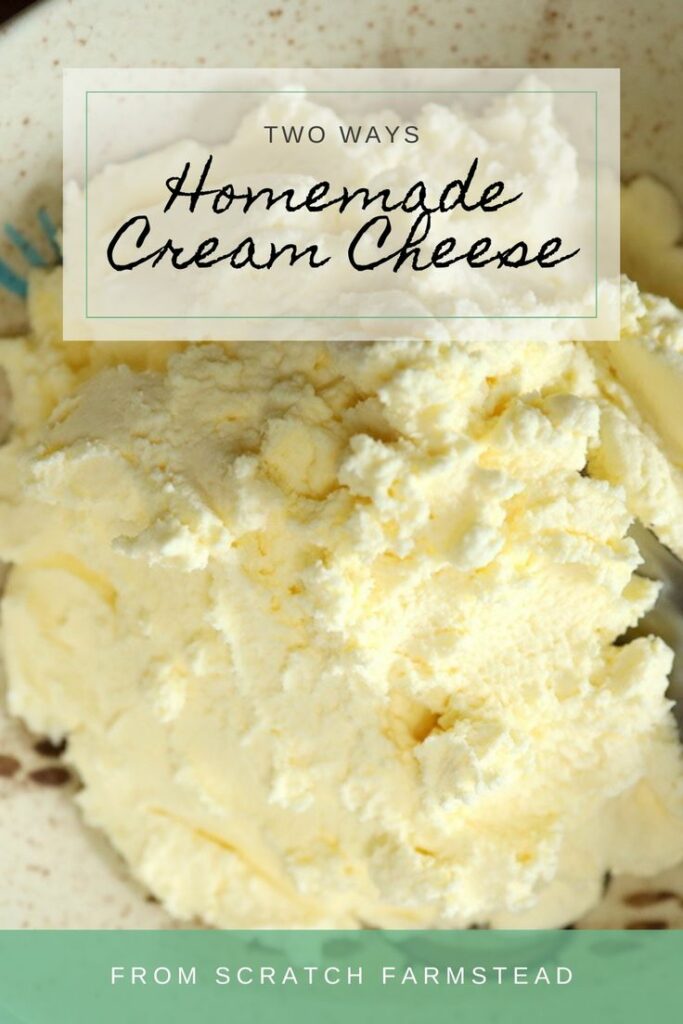

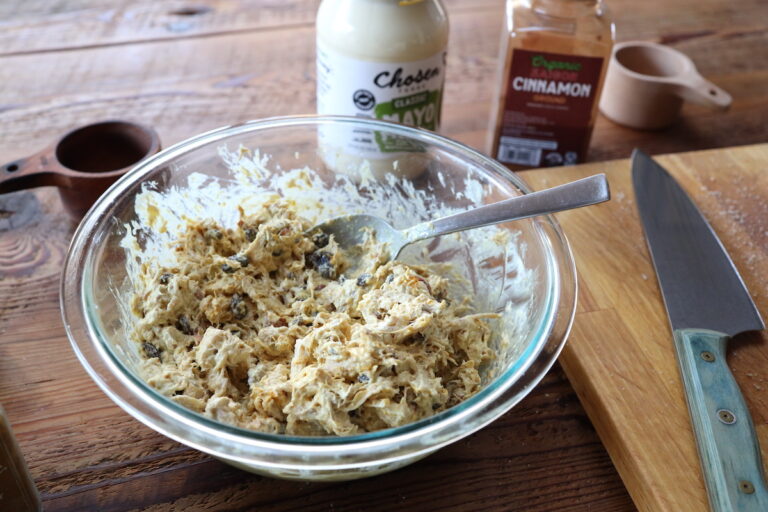




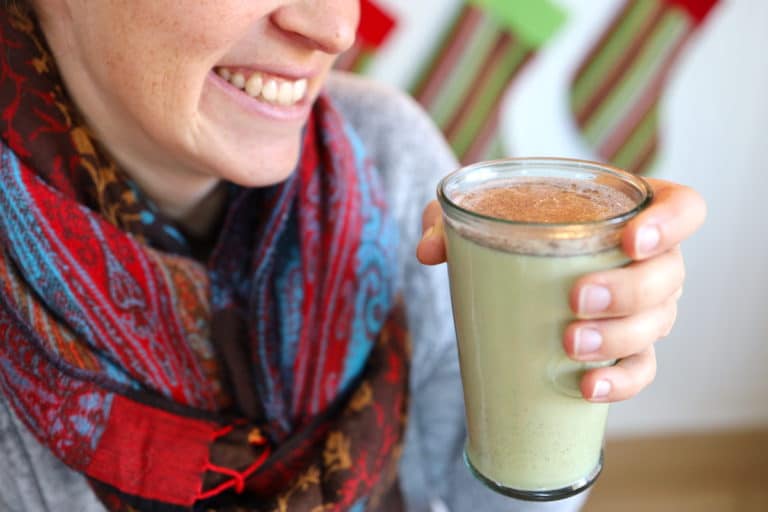
This recipe looks wonderful! Thank you for all of the information. I really want to try the cultured cream cheese version. I was wondering if I can sub anything for the rennet such as gelatin? Thank you!
You’re welcome! The rennet is what separates the curd from the whey in this recipe so I can’t think of anything that would behave the same way. Hope this helps! Enjoy!